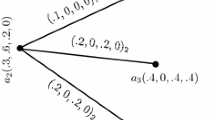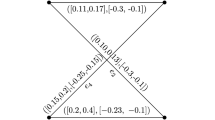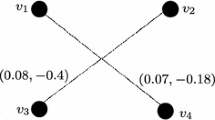Abstract
The main aim of the graph model is to implement the structured representation of data, and the hypergraph can be regarded as a promotion of graph which is used in a wider range of data representation scenarios. Bipolar fuzzy sets are employed to describe the uncertainty of the positive and negative of objectives, and fuzzy graphs are modelled to structure the description of uncertain data. In this work, for bipolar Pythagorean fuzzy set (BPFS) and bipolar intuitionistic fuzzy set (BIFS), the corresponding definitions of bipolar Pythagorean fuzzy hypergraph (BPFH) and bipolar intuitionistic fuzzy hypergraph (BIFH) are given, and they are described from the perspective of set theory. The characteristics under the bipolar hypergraph framework of this representation are discussed.
Supported by Natural Science Foundation of Jiangsu Province, China (BK20191032) and University Philosophy and Social Science research projects of Jiangsu Province (2020SJA1195).
Access this chapter
Tax calculation will be finalised at checkout
Purchases are for personal use only
Similar content being viewed by others
References
Ding, D.Q., Yang, X.G., Xia, F., Ma, T.F., Liu, H.Y., Tang, C.: Unsupervised feature selection via adaptive hypergraph regularized latent representation learning. Neurocomputing 378, 79–97 (2020)
Bouhlel, N., Feki, G., Ben Ammar, A., Ben Amar, C.: Hypergraph learning with collaborative representation for image search reranking. Int. J. Multimedia Inf. Retr. 9(3), 205–214 (2020). https://doi.org/10.1007/s13735-019-00191-w
Lv, X.Q., Wang, X., Wang, Q., Yu, J.Y.: 4D light field segmentation from light field super-pixel hypergraph representation. IEEE Trans. Vis. Comput. Graph. 27(9), 3597–3610 (2021)
Eriksson, A., Edler, D., Rojas, A., de Domenico, M., Rosvall, M.: How choosing random-walk model and network representation matters for flow-based community detection in hypergraphs. Commun. Phys. 4(1), 133 (2021). https://doi.org/10.1038/s42005-021-00634-z
Bai, J.J., Gong, B.A., Zhao, Y.N., Lei, F.Q., Yan, C.G., Gao, Y.: Multi-scale representation learning on hypergraph for 3D shape retrieval and recognition. IEEE Trans. Image Process. 30, 5327–5338 (2021)
Mougouei, D., Powers, D.M.W.: Dependency-aware software requirements selection using fuzzy graphs and integer programming. Expert Syst. Appl. 167, 113748 (2021). https://doi.org/10.1016/j.eswa.2020.113748
Binu, M., Mathew, S., Mordeson, J.N.: Cyclic connectivity index of fuzzy graphs. IEEE Trans. Fuzzy Syst. 29(6), 1340–1349 (2021)
Akram, M., Dudek, W.A.: Intuitionistic fuzzy hypergraphs with applications. Inf. Sci. 218, 182–193 (2013)
Author information
Authors and Affiliations
Corresponding author
Editor information
Editors and Affiliations
Rights and permissions
Copyright information
© 2023 The Author(s), under exclusive license to Springer Nature Switzerland AG
About this paper
Cite this paper
Lu, J., Zhu, L., Gao, W. (2023). Structured Representation of Fuzzy Data by Bipolar Fuzzy Hypergraphs. In: Xu, Y., Yan, H., Teng, H., Cai, J., Li, J. (eds) Machine Learning for Cyber Security. ML4CS 2022. Lecture Notes in Computer Science, vol 13657. Springer, Cham. https://doi.org/10.1007/978-3-031-20102-8_52
Download citation
DOI: https://doi.org/10.1007/978-3-031-20102-8_52
Published:
Publisher Name: Springer, Cham
Print ISBN: 978-3-031-20101-1
Online ISBN: 978-3-031-20102-8
eBook Packages: Computer ScienceComputer Science (R0)




